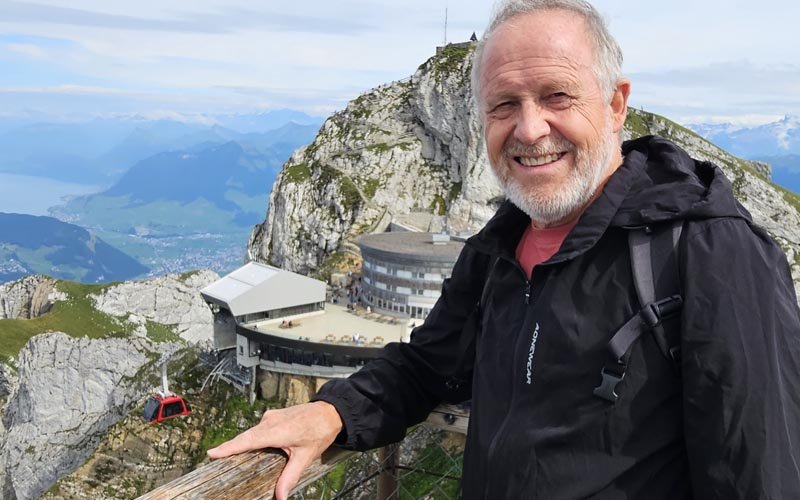15 Dec 2023
Meet Michael Walmsley, Professor of Chemical and Biological Engineering and the Director of the Ahuora Centre for Smart Energy Systems at the University of Waikato. Learn about his role and how he incorporates Te Ao Māori into his courses.
What is your role at the University of Waikato?
I'm a Professor of Chemical and Biological Engineering and the Director of the Ahuora Centre for Smart Energy Systems. Our research centre aims to harness the full potential of renewable energy to power the New Zealand industry using a holistic whole-of-problem approach. This involves developing and using advanced process integration and optimisation, digital twin technology and industry 4.0, clean bioenergy production and industrial symbiosis, integrated and novel thermodynamic cycles and macro-energy sector planning and integration.
I've also served as Programme Leader for the Materials and Process Engineering (MaPE) Programme (2006 to 2016), Programme leader for Chemical and Biological Engineering (CaBE) Programme (2016 to 2021) and Assistant Dean of Engineering Academic (2017 to 2021).

Michael at the top of Mount Pilatus near Lucerne Switzerland. Photo: Michael Walmsley
Tell us about three of your career highlights?
1. Beloit Research Internship: My first sabbatical leave taken at the Beloit Recycle Paper Research Centre in Pittsfield, Massachusetts in 1992 was a career highlight. I was working in the department of Chemical Engineering at Monash University at the time. I was 4 years out from a PhD and determined to get some industry experience to ground my academic career. My time at Beloit was only for 7 months, but after that I worked as a research consultant for Beloit for the next 5 years. They funded some of my pulp and paper research in Australia and New Zealand, and regularly paid for me to present at international conferences and to attend Beloit sales meetings in the USA. My association with Beloit included interactions with the engineering manufacturing team who designed and built the recycle paper equipment and the technical sales team who sold the equipment to the paper mill companies. The overall experience helped to give me an industry perspective that I've maintained in both teaching and research throughout my career.
2. School of Engineering at the University of Waikato: The second career highlight was helping to establish a School of Engineering at the University of Waikato (UoW) from 2000 to present. I returned to New Zealand in 1995 from Australia to take up an academic appointment at the University of Waikato. There was no engineering programme at the University at the time, and nothing was planned to start in the near future. It was quite a career risk, looking back. I came from Monash with a large well established chemical engineering programme and school of engineering, to UoW with a fledgling Centre for Technology and a Bachelor of Science (Technology) work placement programme in the School of Science and Technology. The centre at the time had four and half-staff; a chemist (Alan Langdon) who was the centre leader, two materials scientists/engineers (Nigel Sams and Kim Pickering), a forester (John Bathgate) and a 50% process engineer (Conan Fee). I was appointed as a wood processing lecturer (50%) and the work placement coordinator (50%) in forestry and materials processing. Having grown up in Hamilton I was determined to see the Waikato region flourish and I believed a regional school of engineering at UoW would make a difference over the long term. It took five years to convince the leadership of the University to let a small group of engineering, physics and maths staff start engineering at Waikato. We officially began the Bachelor of Engineering degree (BE) in 2000, initially in niche programmes of Electronics, Materials and Biochemical, then in the pillars of Mechanical and Software, then Chemical for Biochemical, then Civil and Environmental and lastly Mechatronics. I have been involved in all of the accreditation visits since the start of a BE at UoW as a programme leader for MaPE, CaBE or as Assistant Dean academic. I also shaped our curriculum in 2016 to include a more comprehensive coverage of the professional skills learning attributes of the Washington accord. There are now over 700 undergraduate (UG) students studying engineering at UOW and we run a well-supported work integrated learning (WIL) programme that ensures all UOW engineering students get 800 hours of valuable work placements mainly within the central North Island region.
3. Ahuora Centre for Smart Energy Systems: The third highlight has been the establishment of the Ahuora Centre for Smart Energy Systems, within the Division of Health, Engineering, Computing and Science. This has been the culmination of the last 20 years of energy related research at the University of Waikato and brings together energy systems expertise that has been fostered and developed since the establishment of the School of Engineering. The Ahuora Centre has been successful in securing $12.5 million of MBIE funding under the Advanced Energy Platform Technology research programme. The centre consists of over 20 Postgraduate (PG) students and 11 academics across three universities. We are working to help the New Zealand industry decarbonise process heat through improved energy efficiency, through better use of thermodynamic cycles and energy conversion technologies like heat pumps, and through the smart integration of renewable electricity from wind, solar and heat from biomass.
Young students remind you of the miracle of education
With your extensive time in academia, what has changed and what has stayed the same?
The main things that have stayed the same are:
- Engineering degrees are still intellectually challenging and not all students can cope with the work load and academic rigor if they come underprepared or don’t have a strong aptitude for the quantitative sciences, including maths.
- Engineering degrees are still highly valued and they prepare student to be able to solve complex problems across a broad range of areas.
- Student workload remain high and stressful even with lots of modern tools being available and used.
The things that have changed are:
- Engineering education is now seen as much more than preparing students to answer exam questions. Graduate attributes now show the need for the development of a “T” shaped engineering with breadth and depth in their discipline.
- At UoW there is strong emphasis on project based learning (PBL) through societal and engineering design challenges at each year level.
- Online tutoring services like “Chegg” and “AI” tools like ChatGPT are requiring us to modify the way we access students. A return to more face-to-face tests and exams is likely.
What lessons have you learnt from your students over the years?
Young students remind you of the miracle of education. They arrive in first year nervous, unsure, tentative and naïve. They graduate 4 years later full of confidence, self-assured, knowledgeable and ready to tackle the world's challenging problems. This metamorphosis is a joy to behold, and is one of the great satisfying parts of our job. The final year leaving dinner and graduation ceremony are some of the highlights of being an academic.
How do you incorporate Te Ao Māori into your teaching or research?
Improving cultural awareness, especially when teaching and working with Māori and Pacific students, has become a strong focus at UoW, especially over the last 10 years. Cultural awareness applies to both students and staff as we have a wide mix of ethnicities and cultures in the school.
In our Ahuora Centre we have established a Kahui Māori as part of our external advisory board, with six Māori members across three upper North Island iwi. Through this mechanism we are identifying Māori related renewable energy projects that can undertake with Māori PG students for the benefit of Māori. The Far North and the East Coast of New Zealand are two areas where high residential electricity prices exist and these prices may be able to be lowered through distributed renewable solar and or wind.
What would be your dream engineering project to supervise?
I'd love to be part of the decarbonisation of the New Zealand industry to net zero carbon by 2040s through the adoption of the ideas and digital tools we are developing in the Ahuora project
Why are you a member of Engineering New Zealand?
I joined Engineering New Zealand so I could belong to the one engineering professional body in the world that is principally focused on helping New Zealand become the best place possible for our children, grandchildren and future posterity to choose to live. I believe engineers play a vital role in making the world a better place, but at the same time we need to ensure that the solutions and developments we come up with today do not destroy or compromise the wellbeing of future generations.
If you could meet any engineer in the world, who would it be and why?
The stand out engineer of my generation is Elon Musk and I would thoroughly enjoy having dinner with him and his development team. I admire his tenacity to challenge the status quo and to take on the likes of NASA, Ford, General Motors, Toyota etc. He successfully establish the first commercial space company SpaceX that is now paying its way through sending satellites and rockets into space, in some cases on behalf of NASA. Add to this is his visionary work in establishing Telsa to become the most valuable car company in the world and SolarCity, a solar PV company based in California.





